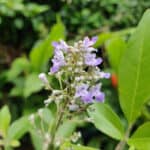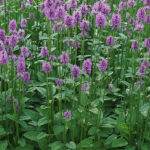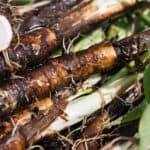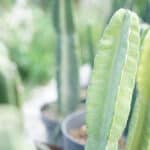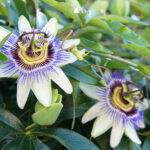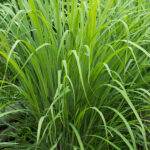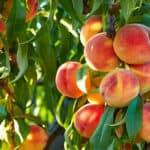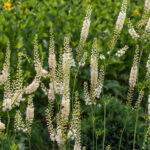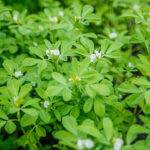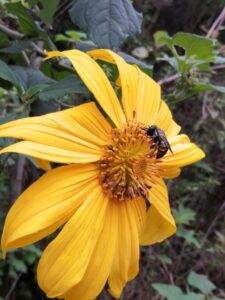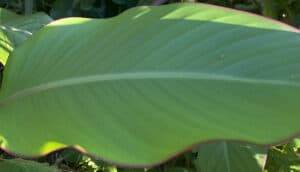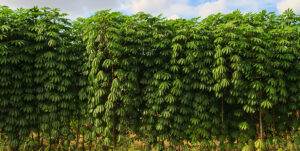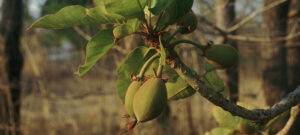Delicate and lovely, California poppy is a delightful medicinal herb to grow in the garden.
Its golden shimmering petals and lacey, feather-like leaves add beauty and grace to the landscape.
California poppy is wonderfully easy to grow and highly medicinal, making it a valuable herb to cultivate and add to your home apothecary.
Plant Overview
Native to the western United States, California poppy grows wild from southern Washington down to northern Mexico.
Its range has expanded to cover much of the West, and you can find isolated patches from Idaho down to Texas.
Thanks to escapee cultivars, California poppy has even been found growing in parts of the Midwest, the Great Lakes region, and the eastern United States.
As California’s state flower, this joyful poppy prefers warm, dry conditions but will grow in various ecosystems.
It grows along roadsides, south-facing mountain slopes, meadows and fields, buffs and beaches, desert landscapes, grasslands, and disturbed ground.
Identification
Because California poppy grows prolifically in parts of the West, it’s helpful to know how to identify this native wildflower.
However, before you go out to harvest this feral beauty, California poppy cannot be wild-harvested on public land in California because it is the state flower.
Other states do not have any California poppy regulations, as it is abundant and widespread.
California poppy is a short-lived herbaceous perennial with blue-green leaves and bright orange to yellow flowers.
In cooler climates, it grows as an annual (Zones 5 and under).
The foliage grows in a basal rosette with smooth leaves that are deeply divided into three-lobed segments.
In late spring to early summer, the plant sends forth long and slender flowering stalks with alternate, feathery leaves.
Each flowering stem bears a single flower.
Beneath the flower bud, enclosed by a green calyx, is a round pedestal or collar.
When the flower blooms, it sheds its calyx, but the collar beneath remains.
This little feature is a key distinguishing characteristic of California poppies.
The flowers have no sepals because the calyx drops when California poppy blooms.
Each flower has four to five smooth and silky wedge-shaped petals.
Spanish settlers called this plant Copa de oro, which means cup of gold in reference to the golden-orange hue of the petals.
When observing this flower, you’ll see that its round cup-like shape and bright, beautiful petals really do resemble a cup of gold.
During the day, the flower will fully unfurl to bask in the heat of the full sun.
When dusk comes, the flowers come together in a swirl and will even stay that way on cloudy, stormy days.
California poppies seedpods are green and elongated, about 1-4 inches.
When it dries, it splits open, revealing small, black seeds.
California Poppy vs. Opium Poppy
When I first learned about California Poppy, I immediately wondered if it contained opium like its cousin, Opium poppy (Papaver somniferum).
Thankfully, California poppy does not contain any opium like its famous relative and is completely safe to ingest.
While California poppy is a sedative and pain-relieving herb, these effects are produced through different biochemical actions than Opium poppy.
Thus, it is not a narcotic, nor is it habit-forming.
It is a gentle and safe remedy (even for young children) and can be used without worry whenever indicated.
Growth and Care
Because California poppy naturally grows in diverse ecosystems, it is incredibly easy to grow in the garden.
As an annual, it can grow in zones 3-6 and as a perennial in zones 8+.
It can grow as a self-seeding annual in slightly warmer climates (zones 5-7).
Some gardeners claim it can grow as an annual in all zones, but I’m not sure if that’s 100% correct (I’m not sure how it would perform in extreme cold, such as zones 1-2 or extreme hot, zones 12-13).
California poppy prefers full sun and well-draining, dry to mesic soil.
Because it naturally grows in nutrient-depleted areas, it does not need rich garden soil.
That said, it is highly adaptable, so it should do just fine in average, moderately fertile garden soil.
There’s no need to add extra nutrients or amendments.
According to medicinal gardener Richo Cech, “The plant does not appreciate coddling!”
Propagation
For best results, scatter California poppy seeds on the surface of loose soil in the fall or early spring.
California poppy does not like its roots disturbed and doesn’t transplant well, so it’s best to directly seed it.
If direct-seeding in the spring, expect germination in about two to three weeks.
If you planted your seeds in the fall, you can expect seedlings to emerge as early as March.
Keep the soil evenly moist, but don’t overwater.
California poppy relishes spring rain, so if you plant the seeds in tandem with coming rainfall, you may not need to water your seedlings.
There’s no need to thin the seedlings – they do just fine close together.
I planted my California poppy seeds in nutrient-poor, sandy soil here in Michigan.
There was a high germination rate, and the plants did extremely well.
They were the most vibrant plants growing in that area (everything else struggled because the soil was so poor).
I live in Zone 5, and my California poppies self-seeded this spring and are coming up happy and healthy.
Case in point – California poppy is like a weed, and it is incredibly easy to establish.
Continued Care
Once established, California poppy is drought-tolerant and incredibly hardy.
Wild poppies flower in the spring, go dormant during the summer heat, and re-flower with fall rains.
If you leave your poppies completely alone and you live in an arid climate, they’ll mimic this cycle.
You can encourage your California poppies to bloom throughout the summer if you water them every so often and harvest the flowers to encourage more blooms.
In more temperate and humid climates, such as the midwest and the eastern United States, frequent summertime rain will be all the California poppy needs.
While harvesting the flowers encourages more blooms, you’ll want to leave some flowers (especially towards the end of the season) so the plants can re-seed.
Harvesting
Harvest California poppy’s leaves and flowers when the plant is in full bloom, preferably in the morning after the dew has dried and the flowers are fully open.
When harvesting the aboveground parts, leave about one-third of each plant so that it can re-grow.
You can harvest a few times throughout the growing season if you leave enough of each plant to regrow.
The roots are also harvested when the plant is in full bloom, but I know less about the root’s uses, so I have no experience harvesting or using the roots myself.
Once harvested, the plant material degrades quickly, especially if left out in the sun.
In light of this, it’s best to transfer your plant material to a drying screen in a dark and well-ventilated area as soon as possible after your harvest.
Or, you can use the freshly harvested plant material to make an alcohol tincture (1:2 ratio in about 70-90% alcohol).
Medicinal Uses
Herbal Actions:
- Nervine relaxant
- Analgesic
- Anti-spasmodic
- Bitter
- Hypnotic
- Hypotensive
Parts Used: Aboveground parts in flower; root
Energetics: Cooling and drying
California poppy is a safe and reliable remedy for nerve-related conditions such as anxiety, stress, and insomnia.
It is also beneficial for nerve-related pain, muscle tension, cramps, and headaches.
California poppy is an incredibly soothing remedy.
It can help relax overly tense nerves, agitation, and restless thoughts.
As a cooling, bitter remedy, it is indicated for nerve conditions that are associated with heat patterns, such as redness in the face, anger, frustration, impatience, sweatiness, and irritation.
It is also associated with nerve-related heart conditions, such as heart palpitations, tension in the chest, and a rapid pulse.
Whenever panic or anxiety results in these physical and psychological patterns, California poppy is a reliable ally that will help settle and cool things down.
As a traditional children’s remedy, California poppy is often given to restless and overly excited children to help them calm down and relax.
It is a gentle sedative, so it will help them sleep if there’s difficulty staying in bed or if there’s a fear of bad dreams.
Interestingly, one of the traditional uses for California poppy is for children who sleep too deeply and don’t wake to use the restroom and subsequently wet the bed.
This use seems paradoxical to its use as a sedative, so I surmise that California poppy does more than just sedate the nervous system and may help regulate sleep patterns (I am theorizing here).
I don’t know much about this traditional use, but I thought I would mention it as I have come across it numerous times.
California poppy can be used in this same way for adults who struggle with insomnia or sleep disturbances, especially if those disturbances are caused by heightened mental activity, anxiety, or muscle or nerve pain.
As a reliable analgesic (pain-relieving agent) and anti-spasmodic, California poppy can be used for all manners of pain associated with muscle tension, damaged nerves, or cramps.
For example, it can help relieve menstrual cramping (and the associated emotional discomfort), intestinal spasms, sciatica, toothaches, and more.
It can also be used as a pain-relieving herb for teething babies.
Herbalist Juliet Blankespoor offers a simple remedy for teething babies: soak a cloth in a chamomile infusion (can also use chickweed, plantain, or licorice).
Once soaked through, put the cloth in the freezer, and once adequately chilled, apply two to three drops each of California poppy tincture and skullcap tincture to the cloth before giving it to the baby to chew on.
California poppy is a straightforward remedy and a wonderful ally to have on hand for all nerve and pain-related symptoms.
I recommend preparing California poppy as a tincture rather than a tea because it has an unpleasant flavor and may be hard to drink.
For general anxiety and stress, start with a lower dose (10-15 drops or .5 mL) three times a day and increase the dosage if necessary.
For a more sedative, or pain-relieving effect, use a larger dose (1-3 mL or one to two dropperfulls).
Be aware that moderate to large doses of California poppy can be sedative and make you feel groggy and tired.
For insomnia, this is great but isn’t preferred for work or the middle of the day.
For children, start with two to three drops and deliver more if necessary (however, I wouldn’t exceed 1 mL in a single serving).
Safety and Contraindications
While California poppy is a safe and gentle remedy, there are a few precautions and contraindications to be aware of.
First, only harvest California poppy from clean, non-toxic locations as the plant can uptake heavy metals.
Do not use during pregnancy.
Large doses may interfere with the ability to operate a vehicle or large machinery.
According to the Chestnut School of Herbal Medicine, California poppy can compound (increase the effects via similar actions) sedative and analgesic medications.
Lastly, if you are on any medication, it’s best to speak with a trusted healthcare professional or qualified herbalist before taking California poppy.



